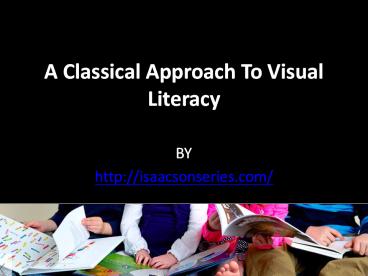A Classical Approach To Visual Literacy - PowerPoint PPT Presentation
Title:
A Classical Approach To Visual Literacy
Description:
One aspect of visual literacy requires us to recognize the synergy of language and imagery. Using language to enhance visual perception is a technique steeped in the classic rhetorical principle of ekphrasis. The Magic Museum, The Isaacson Series In Youth Literature emphasizes on innovative approach in storytelling. – PowerPoint PPT presentation
Number of Views:32
Updated: 23 August 2014
Slides: 6
Provided by:
themagicmuseum
Category:
How To, Education & Training
Tags:
Title: A Classical Approach To Visual Literacy
1
A Classical Approach To Visual Literacy
- BY
- http//isaacsonseries.com/
2
One aspect of visual literacy requires us to
recognize the synergy of language and imagery.
Using language to enhance visual perception is a
technique steeped in the classic rhetorical
principle of ekphrasis. This methodology employs
an image/s to inspire the content of a narrative
through the careful examination and application
of its shape, color, texture, expression, and
symbolic content. This differs from the classic
use of visual aids, which are usually devised to
reinforce a pre-existing text. This construction
of storytelling encourages the listener or reader
to scan the supportive imagery for its suggested
detail. The result is an evocative, image-rich
text that both transports the listener and
fosters a key element of visual literacy, often
defined as the intellectual methods used to
appreciate, understand, create and critically
assess visual messages.
3
Acquiring visual literacy has become increasingly
essential, given the vast expansion of visual
forms of mass communication. Mary Alice Whites
research finds that young people acquire more
than half of their knowledge from visually
transmitted information. While artists have
historically used their work to depict stories,
ekphratic tools in the form of deconstructive
questions can be used to create stories from
compelling still imagery. The following set of
questions can be applied to help reveal the
narrative potential of fine art images. Who?
How many people appear in the image? Who do you
imagine they are and why were they chosen? What
action? What can you imagine each character in
the image doing or thinking?
4
What mood? Can you tell what each character is
feeling? Where? Determine where this scene is
taking place. When? When do you think this
scene is taking place? What do you see that
makes you come to your conclusions? How can a
successive grouping of images guide the
progression of the narrative? I applied this
ekphratic technique to thirteen images by French
Impressionist Edgar Degas to create a childrens
story, The Magic Museum, a tale about an aspiring
ballerina. Elements of the paintings, gleaned
from asking the above questions, drive the text,
encouraging the listener or reader to carefully
scan each image for detail essential to the
narrative. This application of the classic
method of ekphrasis serves to generate evocative,
finely focused language, and to expand the
integration of art and storytelling, thereby
contributing to the development of a more
visually literate listener or reader.
5
The Magic Museum, The Isaacson Series in Youth
Literature - An enchanting children's book that
tells the story of a 12-year old skateboarder
(Jack) and a ballerina (Jacqueline) who whispers
to him from an Edgar Degas painting in a fine
arts museum. A wonderful way for parents to
introduce fine art and engage children (ages 8 to
12 years old) in the art of visual storytelling
and imagination. For More Information on The
Magic Museum Book, visit - http//www.isaacsonseri
es.com































